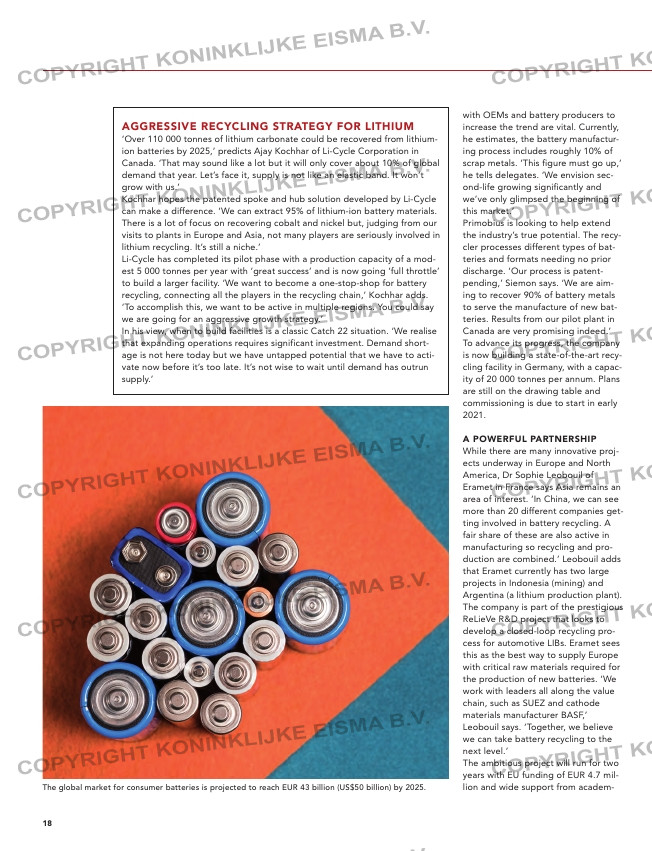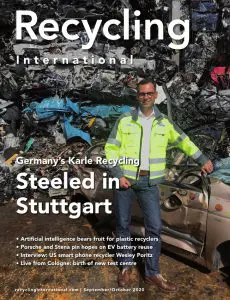Page 18 from: New issue out now!

18
with OEMs and battery producers to
increase the trend are vital. Currently,
he estimates, the battery manufactur-
ing process includes roughly 10% of
scrap metals. ‘This figure must go up,’
he tells delegates. ‘We envision sec-
ond-life growing significantly and
we’ve only glimpsed the beginning of
this market.’
Primobius is looking to help extend
the industry’s true potential. The recy-
cler processes different types of bat-
teries and formats needing no prior
discharge. ‘Our process is patent-
pending,’ Siemon says. ‘We are aim-
ing to recover 90% of battery metals
to serve the manufacture of new bat-
teries. Results from our pilot plant in
Canada are very promising indeed.’
To advance its progress, the company
is now building a state-of-the-art recy-
cling facility in Germany, with a capac-
ity of 20 000 tonnes per annum. Plans
are still on the drawing table and
commissioning is due to start in early
2021.
a powerful partnership
While there are many innovative proj-
ects underway in Europe and North
America, Dr Sophie Leobouil of
Eramet in France says Asia remains an
area of interest. ‘In China, we can see
more than 20 different companies get-
ting involved in battery recycling. A
fair share of these are also active in
manufacturing so recycling and pro-
duction are combined.’ Leobouil adds
that Eramet currently has two large
projects in Indonesia (mining) and
Argentina (a lithium production plant).
The company is part of the prestigious
ReLieVe R&D project that looks to
develop a closed-loop recycling pro-
cess for automotive LIBs. Eramet sees
this as the best way to supply Europe
with critical raw materials required for
the production of new batteries. ‘We
work with leaders all along the value
chain, such as SUEZ and cathode
materials manufacturer BASF,’
Leobouil says. ‘Together, we believe
we can take battery recycling to the
next level.’
The ambitious project will run for two
years with EU funding of EUR 4.7 mil-
lion and wide support from academ-
ics. ‘We want to recover battery grade
metals – pure black mass powder –
from the lithium-ion waste stream so
we can manufacture anode materials
precursors,’ Leobouil explains. ‘We
apply a hydrometallurgical process
and after leaching we get up to 98%
of metals back. We can boost this to
99%.’
Ultimately, ReLieve plans to:
• Test the novel process at pilot scale
and design an industrial-scale facility
• Conduct a detailed assessment of
the best way to collect and disman-
tle LIBs, sort and discharge cells with
an overall evaluation of the added
value of automation tools (SUEZ
responsibility)
• Include a digital component (based
on modelling work of the Norwegian
University of Science and
Technology) to design a flexible
recycling unit that can adapt to the
chemical grades expected in future
LIB products
• Complete qualification for the LIB
precursors that already exist, such as
nickel sulphate, as well as new prod-
ucts that could be suitable for cath-
ode manufacturing (BASF responsi-
bility).
Daimler is lending support to the ini-
tiative by providing guidance and
technical know-how from the car man-
ufacturer’s point of view. Leobouil
stresses this close collaboration is key
to getting the best end result.
double closed-loop
Dr Farouk Tedjar of Tes AMM Central
Europe agrees that keeping a wide
view of battery recycling is the way
forward. ‘We recently established two
recycling facilities, one in Singapore
and one France, to treat e-scrap bat-
teries. The plants realise a double
closed-loop, if you will, because we
also recycle the wastewater,’ he
explains.
The new facilities feature a proprietary
process to discharge batteries safely
before crushing them into different
fractions such as ferrous and non-fer-
rous metals, plastics and black mass.
‘From there we can safely refine the
material back into commodity grade
elements: cobalt, aluminium, copper
aggressive recycling strategy for lithiuM
‘Over 110 000 tonnes of lithium carbonate could be recovered from lithium-
ion batteries by 2025,’ predicts Ajay Kochhar of Li-Cycle Corporation in
Canada. ‘That may sound like a lot but it will only cover about 10% of global
demand that year. Let’s face it, supply is not like an elastic band. It won’t
grow with us.’
Kochhar hopes the patented spoke and hub solution developed by Li-Cycle
can make a difference. ‘We can extract 95% of lithium-ion battery materials.
There is a lot of focus on recovering cobalt and nickel but, judging from our
visits to plants in Europe and Asia, not many players are seriously involved in
lithium recycling. It’s still a niche.’
Li-Cycle has completed its pilot phase with a production capacity of a mod-
est 5 000 tonnes per year with ‘great success’ and is now going ‘full throttle’
to build a larger facility. ‘We want to become a one-stop-shop for battery
recycling, connecting all the players in the recycling chain,’ Kochhar adds.
‘To accomplish this, we want to be active in multiple regions. You could say
we are going for an aggressive growth strategy.’
In his view, when to build facilities is a classic Catch 22 situation. ‘We realise
that expanding operations requires significant investment. Demand short-
age is not here today but we have untapped potential that we have to acti-
vate now before it’s too late. It’s not wise to wait until demand has outrun
supply.’
The global market for consumer batteries is projected to reach EUR 43 billion (US$50 billion) by 2025.
16-17-18-19-20-21_batteryrecyclingupdate.indd 18 29-09-20 08:54



